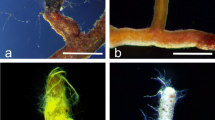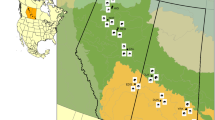Abstract
Coarse woody debris (CWD)is an important nursery environment for many tree species. Understanding the communities of ectomycorrhizal fungi (ECMF)and the effect of ECMF species on tree seedling condition in CWD will elucidate the potential for ECMF-mediatedeffects on seedling dynamics. In hemlock-dominatedstands, we characterized ECMF communities associated with eastern hemlock (Tsuga canadensis (L.) Carr) and yellow birch (Betula alleghaniensis Britt) seedling pairs growing on CWD. Seedling foliage and CWD were analyzed chemically, and seedling growth, canopy cover, and canopy species determined. Thirteen fungal taxa, 12 associated with birch, and 6 with hemlock, were identified based on morphology and ITS sequencing. Five species were shared by co-occurringbirch and hemlock, representing 75 % of ectomycorrhizal root tips. Rarified ECMF taxon richness per seedling was higher on birch than hemlock. Nonmetric multidimensional scaling revealed significant correlations between ordination axes, the mutually exclusive ECMF Tomentella and Lactarius spp., foliar N and K, CWD pH, and exchangeable Ca and Mg. Seedlings colonized by Lactarius and T. sublilacina differed significantly in foliar K and N, and CWD differed in exchangeable Ca and Mg. CWD pH and nutrient concentrations were low but foliar macro-nutrientconcentrations were not. We hypothesize that the dominant ECMF are adapted to low root carbohydrate availability typical in shaded environments but differ in their relative supply of different nutrients.




Similar content being viewed by others
References
Agerer R (1987–2006) Colour Atlas of Ectomycorrhizae. Einhorn-VerlagEduard Dietenberger, Schwäbisch Gmünd, Germany.
Ahonen-Jonnarth U, Göransson A, Finlay RD (2003)Growth and nutrient uptake of ectomycorrhizal Pinus sylvestris seedlings in a natural substrate treated with elevated Al concentrations. Tree Physiol 23:157–167
Arnolds E (1991) Decline of ectomycorrhizal fungi in Europe. Agric Ecosyst Environ 35:209–244
Arora D (1986) Mushrooms demystified. Ten Speed Press, Berkeley
Bates D, Maechler M, Bolker B, Walker S (2013)Linear mixed-effectsmodels using Eigen and S4 v. 1.0-5 <http://lme4.r-forge.r-project.org/>
Berndt LW (1988) Soil survey of Baraga County area, Michigan. USDA Soil Conservation Service, Washington
Bingham MA, Simard SW (2012) Mycorrhizal networks affect ectomycorrhizal fungal community similarity between conspecific trees and seedlings. Mycorrhiza 22:317–326
Bloom AJ, Chapin FS, Mooney HA (1985) Resource limitation in plants—an economic analogy. Annu Rev Ecol Syst 16:363–392
Booth MG, Hoeksema JD (2010) Mycorrhizal networks counteract competitive effects of canopy trees on seedling survival. Ecology 91:2294–2302
Brundrett MC, Kendrick B (1988) The mycorrhizal status, root anatomy, and phenology of plants in a sugar maple forest. Can J Bot 66:1153–1173
Brundrett M, Murase G, Kendrick B (1990) Comparative anatomy of roots and mycorrhizae of common Ontario trees. Can J Bot 68:551–578
Burke DJ, López-Gutiérrez JC, Smemo KA, Chan CR (2009) Vegetation and soil environment influence the spatial distribution of root-associated fungi in a mature beech-maple forest. Appl Environ Microbiol 75:7639–7648
Colwell R (2013) EstimateS: Statistical estimation of species richness and shared species from samples v. 9.0.0. <purl.oclc.org/estimates>
Colwell RK, Mao CX, Chang J (2004) Interpolating, extrapolating, and comparing incidence-based species accumulation curves. Ecology 85:2717–2727
Coomes DA, Grubb PJ (2000) Impacts of root competition in forests and woodlands: a theoretical framework and review of experiments. Ecol Monogr 70:171–207
Druebert C, Lang C, Valtanen K, Polle A (2009) Beech carbon productivity as driver of ectomycorrhizal abundance and diversity. Plant Cell Environ 32:992–1003
Egerton-Warburton LM, Querejeta JI, Allen MF (2007) Common mycorrhizal networks provide a potential pathway for the transfer of hydraulically lifted water between plants. J Exp Bot 58:1473–1483
Erdmann GG (1990) Yellow Birch. In: Burns RM, Honkala BH (eds)Silvics of North America, vol 2. Hardwoods, USDA For Serv, Washington
Erland S, Taylor AF (2002) Diversity of ecto-mycorrhizal fungal communities in relation to the abiotic environment. In: van der Heijden MG, Sanders I (eds)Mycorrhizal ecology. Springer, Berlin, pp 163–200
Finlay R (1995) Interactions between soil acidification, plant growth and nutrient uptake in ectomycorrhizal associations of forest trees. Ecol Bull 44:197–214
Fox J, Weisberg S (2011) An {R} Companion to Applied Regression v. 2.0-19, Thousand Oaks, CA, USA <http://socserv.socsci.mcmaster.ca/jfox/Books/Companion>
Godman RM, Lancaster K (1990) Eastern Hemlock. In: Burns RM, Honkala BH (eds) Silvics of North America, vol 1. Conifers, USDA For Serv, USA
Harmon ME, Franklin JF, Swanson FJ, Sollins P, Gregory S, Lattin J, Anderson N, Cline S, Aumen N, Sedell J (1986) Ecology of coarse woody debris in temperate ecosystems. Adv Ecol Res 15:133–302
He X-H, Critchley C, Bledsoe C (2003) Nitrogen transfer within and between plants through common mycorrhizal networks (CMNs). Crit Rev Plant Sci 22:531–567
Holloway GL, Malcolm JR (2007) Nest-tree use by northern and southern flying squirrels in central Ontario. J Mammal 88:226–233
Horton TR, Bruns TD (2001) The molecular revolution in ectomycorrhizal ecology: peeking into the black-box. Mol Ecol 10:1855–1871
Ishida TA, Nara K, Hogetsu T (2007) Host effects on ectomycorrhizal fungal communities: insight from eight host species in mixed conifer–broadleaf forests. New Phytol 174:430–440
Jochner S, Höfler J, Beck I, Göttlein A, Ankerst DP, Traidl-Hoffmann C, Menzel A (2013) Nutrient status: a missing factor in phenological and pollen research? J Exp Bot 64:2081–2092
Jongbloed R, Borst-Pauwels G (1992) Effects of aluminium and pH on growth and potassium uptake by three ectomycorrhizal fungi in liquid culture. Plant Soil 140:157–165
Kennedy P, Izzo A, Bruns T (2003) There is high potential for the formation of common mycorrhizal networks between understorey and canopy trees in a mixed evergreen forest. J Ecol 91:1071–1080
Kennedy PG, Hortal S, Bergemann SE, Bruns TD (2007) Competitive interactions among three ectomycorrhizal fungi and their relation to host plant performance. J Ecol 95:1338–1345
Kernaghan G (2005) Mycorrhizal diversity: cause and effect? Pedobiologia 49:511–520
Kernaghan G, Patriquin G (2011) Host associations between fungal root endophytes and boreal trees. Microb Ecol 62:460–473
Kitajima K (1994) Relative importance of photosynthetic traits and allocation patterns as correlates of seedling shade tolerance of 13 tropical trees. Oecologia 98:419–428
Lilleskov EA, Bruns TD (2003) Root colonization dynamics of two ectomycorrhizal fungi of contrasting life history strategies are mediated by addition of organic nutrient patches. New Phytol 159:141–151
Lilleskov EA, Parrent JL (2007) Can we develop general predictive models of mycorrhizal fungal community–environment relationships? New Phytol 174:250–256
Lilleskov EA, Fahey TJ, Horton TR, Lovett GM (2002) Belowground ectomycorrhizal fungal community change over a nitrogen deposition gradient in Alaska. Ecology 83:104–115
Lilleskov E, Hobbie E, Horton T (2011) Conservation of ectomycorrhizal fungi: exploring the linkages between functional and taxonomic responses to anthropogenic N deposition. Fungal Ecol 4:174–183
Marx LM, Walters MB (2006) Effects of nitrogen supply and wood species on Tsuga canadensis and Betula alleghaniensis seedling growth on decaying wood. Can J For Res 36:2873–2884
McCune B, Grace JB (2002) Analysis of ecological communities. MjM Software Design, Gleneden Beach
McCune B, Mefford MJ (2011) PC-ORD: multivariate analysis of ecological data v. 6.08. MjM Software Design, Gleneden Beach
Mengel K, Kosegarten H, Kirkby EA, Appel T (2001) Principles of plant nutrition. Springer
Midwest Regional Climate Center (2012) Alberta, Michigan, USA snowfall summary; data reported through 2000. <http://mrcc.isws.illinois.edu/climate_midwest/historical/snow/mi/200089_ssum.html> accessed 10.27.12
Miller RO (1998) High-temperature oxidation: dry ashing. In: Kalra YP (ed)Handbook and reference methods for plant analysis. CRC Press, NY, USA, pp 53–56
Mladenoff DJ, Stearns F (1993) Eastern hemlock regeneration and deer browsing in the northern Great Lakes region: a re-examination and model simulation. Conserv Biol 7:889–900
Mohatt KR, Cripps CL, Lavin M (2008) Ectomycorrhizal fungi of whitebark pine (a tree in peril) revealed by sporocarps and molecular analysis of mycorrhizae from treeline forests in the Greater Yellowstone Ecosystem. Botany 86:14–25
Molina R, Massicotte H, Trappe JM (1992) Specificity phenomena in mycorrhizal symbioses: community-ecological consequences and practical implications. In: Allen MF (ed) Mycorrhizal Functioning: an Integrative Plant-Fungal Process. Chapman and Hall, New York, pp 357–423
Murata M, Kinoshita A, Nara K (2013) Revisiting the host effect on ectomycorrhizal fungal communities: implications from host-fungal associations in relict Pseudotsuga japonica forests. Mycorrhiza 23:641–653
National Oceanic and Atmospheric Administration (NOAA) (2012) Alberta, Michigan, USA weather station; data reported through 2010. <www.ncdc.noaa.gov/cdo-web/search> accessed 2.10.12
Newman E (1988) Mycorrhizal links between plants: their functioning and ecological significance. Adv Ecol Res 18:243–270
Penn State University College of Agricultural Sciences (2014) Interpretive Nutrient Levels for Plant Analysis. < http://agsci.psu.edu/aasl/plant-analysis/plant-tissue-total-analysis/interpretive-nutrient-levels-for-plant-analysis>. Accessed 1.12.14
Peterson RL, Massicotte HB, Melville LH (2004) Mycorrhizas: anatomy and cell biology. CABI, Wallingford
Philip L, Simard S, Jones M (2010) Pathways for below-ground carbon transfer between paper birch and Douglas-fir seedlings. Plant Ecol Divers 3:221–233
Qian X, Kottke I, Oberwinkler F (1998) Influence of liming and acidification on the activity of the mycorrhizal communities in a Picea abies (L.) Karst. stand. Plant Soil 199:99–109
R Core Team (2013) R: a language and environment for statistical computing. v. 3.0.2. R Foundation for Statistical Computing, Vienna. <www.r-project.org/>
Rineau F, Garbaye J (2009) Does forest liming impact the enzymatic profiles of ectomycorrhizal communities through specialized fungal symbionts? Mycorrhiza 19:493–500
Rogers RS (1978) Forests dominated by hemlock (Tsuga canadensis): distribution as related to site and postsettlement history. Can J Bot 56:843–854
Selosse M-A, Richard F, He X, Simard SW (2006) Mycorrhizal networks: des liaisons dangereuses? Trends Ecol Evol 21:621–628
Simard SW, Durall DM (2004) Mycorrhizal networks: a review of their extent, function, and importance. Can J Bot 82:1140–1165
Smith A (2013) The Role of Ectomycorrhizal Fungi on Fertilized and Unfertilized Nursery Grown White Spruce. Master's Thesis, Michigan Technological University, http://digitalcommons.mtu.edu/etds/583
Smith S, Read D (1997) Mycorrhizal symbiosis. Academic Press, San Diego
Sollins P (1982) Input and decay of coarse woody debris in coniferous stands in western Oregon and Washington. Can J For Res 12:18–28
Tedersoo L, Kõljalg U, Hallenberg N, Larsson K-H (2003) Fine scale distribution of ectomycorrhizal fungi and roots across substrate layers including coarse woody debris in a mixed forest. New Phytol 159:153–165
Tedersoo L, Suvi T, Jairus T, Kõljalg U (2008) Forest microsite effects on community composition of ectomycorrhizal fungi on seedlings of Picea abies and Betula pendula. Environ Microbiol 10:1189–1201
Trudell SA, Edmonds RL (2004) Macrofungus communities correlate with moisture and nitrogen abundance in two old-growth conifer forests, Olympic National Park, Washington, USA. Can J Bot 82:781–800
Turner G, Lewis J, Mates-Muchin J, Schuster W, Watt L (2009) Light availability and soil source influence ectomycorrhizal fungal communities on oak seedlings grown in oak- and hemlock-associated soils. Can J For Res 39:1247–1258
van der Heijden MG, Horton TR (2009) Socialism in soil? The importance of mycorrhizal fungal networks for facilitation in natural ecosystems. J Ecol 97:1139–1150
Walters MB, Reich PB (1996) Are shade tolerance, survival, and growth linked? Low light and nitrogen effects on hardwood seedlings. Ecology 77:841–853
Watkins NK, Fitter AH, Graves JD, Robinson D (1996) Carbon transfer between C-3 and C-4 plants linked by a common mycorrhizal network, quantified using stable carbon isotopes. Soil Biol Biochem 28:471–477
Yamasaki M, DeGraaf RM, Lanier JW (2000) Wildlife habitat associations in eastern hemlock -birds, smaller mammals, and forest carnivores. In: Proceedings: symposium on sustainable management of hemlock ecosystems in eastern North America, GTR-NE-267, pp. 135–143
Zhou M, Sharik TL (1997) Ectomycorrhizal associations of northern red oak (Quercus rubra) seedlings along an environmental gradient. Can J For Res 27:1705–1713
Acknowledgments
Funding for this project was provided by the McIntire-StennisCooperative Forestry Research Program, the Ecosystem Science Center at Michigan Technological University, and by the USDA Forest Service, Northern Research Station, Houghton, MI. We would especially like to thank Louis J. Lamit for help with statistical analysis and Lynette Potvin for help with laboratory techniques and methods. We would also like to thank two anonymous reviewers for commenting on earlier drafts of this manuscript.
Author information
Authors and Affiliations
Corresponding author
Rights and permissions
About this article
Cite this article
Poznanovic, S.K., Lilleskov, E.A. & Webster, C.R. Sharing rotting wood in the shade: ectomycorrhizal communities of co-occurringbirch and hemlock seedlings. Mycorrhiza 25, 153–164 (2015). https://doi.org/10.1007/s00572-014-0597-0
Received:
Accepted:
Published:
Issue Date:
DOI: https://doi.org/10.1007/s00572-014-0597-0




